Bronedreziny family "Matval"
History technology called "Matval" made to conduct with 1915 year. Then the future designer of railway equipment Sevastyan Sevastyanovich Waldner was drafted into the army and assigned to an automobile company. Waldner showed great interest in automotive technology and quickly mastered the operation and maintenance of existing machines. Shortly after the start of service, Waldner, together with the company commander Mattisson, developed his own design of the gearbox, for which a patent was soon received. The new gearbox was named after the first letters of the names of its creators - “Matval”. The new unit was assembled from the available components. The proposed gearbox provided the movement with the same speed both forward and backward. Thanks to this, it could be used on light rail vehicles, for example, on various rail cars and carriages.
In the future, Mattisson and Waldner continued to work together, which resulted in several new technology projects created with extensive use of existing components and assemblies. Some of the cars offered were assembled in the conditions of an army workshop and tested on highways and railways. However, fame and vocation came to Mattisson and Waldner later, after the October Revolution.
After the revolution, motorists-engineers became Red Army men and continued their work in the interests of the new authorities. By the beginning of autumn 1919, they completed the development and construction of a new cargo rail car, built on the basis of the aggregates of one of the production trucks. During testing, this machine was able to develop the speed of 90 km / h, which attracted the attention of the command of the troops of the Cheka. December 27 of the same year was already organized by the Matval Office or the Matvalbyuro for the railways of the RSFSR during the Military Council of the RSFSR. SS became the head of the new organization. Waldner.
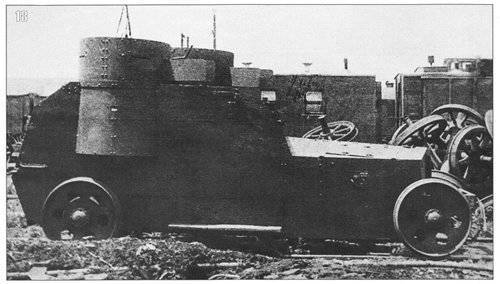
Izhora "Matval"
Red Army soldiers and security officers needed a large number of armored vehicles with cannon and machine gun weapons, which could be used in battles of the Civil War. To accomplish the task of providing the troops with the necessary equipment, a special design bureau was organized. In addition, Putilov and Izhora plant were involved in new projects. The first of them was to participate in the development and construction of the chassis for the technology, and the task of the second was to assist with the booking.
In February, 1920 of the year at the Izhora plant completed the assembly of the first armored rubber of a new type. On the basis of existing units and with the use of new components an armored car was assembled, equipped with a special undercarriage for movement on the railway. The car was equipped with armor thickness 7 mm. The crew of eight people could use the gun Hotchkiss caliber 37 mm (SA18) and four Maxim machine guns. The gun was located in a rotating turret on the roof of the hull, machine guns - in the side embrasures.
The Matval valved railcar of the first version should have a sufficiently high firepower and acceptable driving characteristics. However, tests have shown that the proposed design does not fully meet the requirements of the customer. Chassis, power plant and other components of the new machine required improvement. Bronedrezina turned out overweight and had insufficient speed. In addition, the springs were too weak for a heavy car. Finally, the size of the habitable armored tires was insufficient and did not provide an acceptable convenience for the crew.
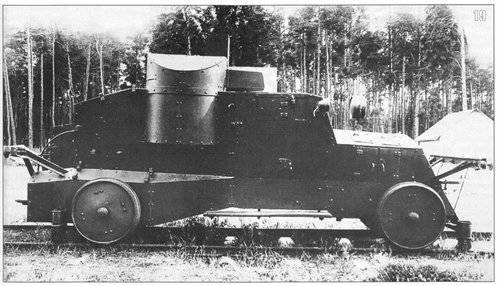
Sormovsky "Matval" 1920 of the year
In April, 1920, the designers and industry leaders held a meeting, during which plans were made for the further development of the Matval family of equipment. It was decided that Matvalbyuro and Izhora Plant should prepare draft designs of two armored vehicles based on the White truck chassis. The first was planned to be equipped with two turrets with machine guns, the second with an 37-mm cannon in the turret and machine-guns in the body, with the possibility of firing in any direction. In the buildings of the new technology was required to provide embrasures in the middle part of the sides, intended for firing from personal weapons in the "from the knee" position. With the help of these embrasures, it was planned to bombard targets on a railway embankment, in the immediate vicinity of the car.
Until the end of 1920, Matvalbyuro not only developed a new project, but also managed to build four armored tires. It should be noted that they were not built on the basis of the White trucks. The basis for them was the Sheffield-Simplex armored cars, although it was not done without borrowing the units from White machines. The latter, in particular, “shared” the rear axles. Replacing the originally designed chassis solved the problem of using existing equipment. Back in 1915-16, the British company Sheffield-Simplex supplied the Russian empire 25 light machine gun armored vehicles of its design. Tests have shown that this technique cannot be used by the army due to its low characteristics. As a result, the Sheffield-Simplex armored cars mostly stood idle. The new version of the Matval armored rubber, among other things, was intended to find a use in a considerable number, but useless machines.
The Sheffield-Simplex armored car was equipped with protection in the form of steel rolled sheets with a thickness of 8 mm. The power plant was based on a petrol engine rated at 30 hp. (according to other sources, 22 hp). On the roof of the hull two towers with Maxim machine guns were planned. During the construction of the new armored rubber base armored cars underwent major changes. First of all, they concerned the hull structure. British engineers built an armored hull on the basis of a wooden frame. Because of this, the workers of the Izhora plant had to remove all protection from the armored car, dismantle the native frame and make a new metal one. To improve performance, the rear axle Sheffield Simplex was replaced by a similar unit borrowed from the White car. Also armored rubber got an additional gas tank and railway wheels with a diameter of 800 mm. After all such improvements, the Matval machine's curb weight reached 5750 kg. The crew of the new armored tire consisted of five people. On the roof of the case were kept two towers with machine guns.
During the tests, the Matval armored rubber vehicle based on the Sheffield-Simplex armored vehicle was able to reach 50 km / h. In terms of speed, the new armored vehicle lost to previous designs by Waldner and Mattisson, however, the existing characteristics were considered sufficient. In 1920, four similar armored tires were manufactured. After testing, they were sent to the troops of the Western and South-Western fronts.
In parallel with the work at Matvalbyuro, the designers of the Izhora and Putilov factories were engaged in developing their projects. First of all, the specialists of the enterprises were engaged in the creation of new reservations and weapons for railway equipment. At the very beginning of 1921, the Council of the military industry decided to build two prototype Bronedrezin "Matval" with some differences and features. One of them was proposed to be built according to the project of the Izhora plant with two machine-gun turrets. This car was required to pass before the end of April. Until the end of June, the Putilov factory was to hand over the Matval with its own design armor, as well as weapons in the form of an 3-inch gun and two machine guns.
By the time of the commencement of the construction of the required prototype machines, the production of “Matval” bronedrezin was partially transferred to the settlement of Springs near Yaroslavl. Machines were built with the use of newly manufactured and dismantled units with damaged equipment. On the basis of common technical solutions, both armored fighting railcars and cargo or passenger vehicles were built. Due to the general difficulties that the industry had at that time, the rate of production of armored rubber remained small. Nevertheless, the workers from the Springs, as well as the Putilov and Izhora Works, tried to provide the army with the necessary equipment in time.
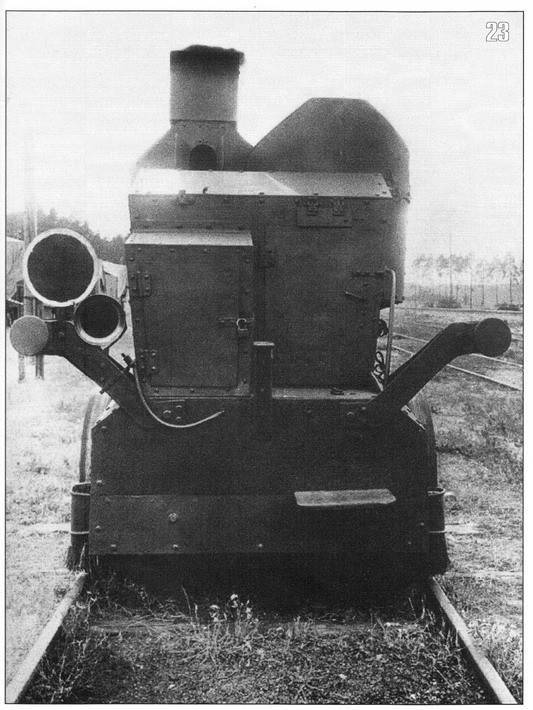
It is known that by March 1922, several domestic factories had built Matval 4 armored vehicles based on Sheffield-Simplex armored vehicles, 1 armored vehicles based on other components, 3 cargo railways and 13 passenger cars. Thus, in just a couple of years, more than two dozen Matval railcars of several types were manufactured. In the same March, 22 8 vehicles were unfinished in the factory workshops: 2 combat, 2 cargo and 4 passenger. In addition, at the Rodnikovskoye and Putilovskiy plants there was a fairly large number of built chassis - at least 30 units. However, these chassis were not provided with engines. The power plant received only half of the chassis, and a considerable part of the engines were already in operation, as a result of which its resource left much to be desired.
The plans of the army and "Matvalbyuro" was the construction of a sufficiently large number of armored vehicles of various modifications, differing from each other in armor, weapons and other features. Nevertheless, the capabilities of the industry had a serious impact on the release of new technology. So, in 1920 for 1922 years only 9 machines of several versions were built. This vehicle received tail numbers from 30 to 37 and was distributed among the Red Army units. The armored vehicles served in the 1-th and 7-th separate divisions of armored trains, as well as in the 2-th regiment of armored trains.
The overwhelming majority of built Matval armored vehicles were armed with machine guns. The gun was equipped with only one car. Its operation continued for various reasons until the 1925 year. After that, the gun armored rubber was written off and disposed of. The operation of the remaining technology lasted longer. It is noteworthy that the new armored tires did not manage to fully realize their potential speed. Due to the unsatisfactory condition of the railway tracks, armored tires could reach speeds of no more than 40 km / h when driving on straight sections. Near the stations and on curved sections of the path, we had to slow down to 15 km / h.
Already during the operation the military had to face the problem of supplying spare parts. Technique of those times did not differ high resource, and the required number of spare units was absent. Some measures were taken, but by the beginning of the thirties, the Matval armored rubber tires had ceased to suit the military in all respects, both in terms of performance and in terms of service. In the early thirties, all the remaining 8 machines were transferred to the category of training. However, in this quality they are almost never used. Due to the lack of repair operation of the equipment was difficult. In some cases, there was no opportunity to get the necessary parts.
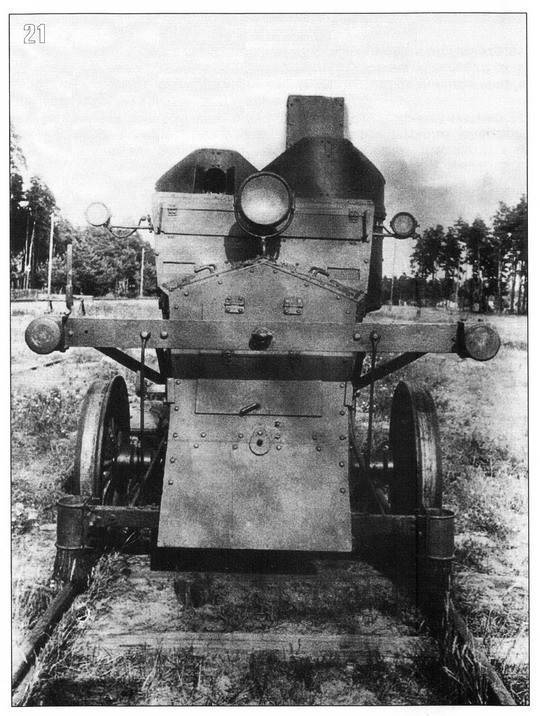
Training armored rubber "Matval" were listed as part of the fleet of vehicles of the Red Army until 1938, when they were written off because of the full development of the resource. Soon, almost all cars were disposed of. According to various sources, one or two armored tires were restored with the help of spare parts, removed from the other equipment, and transferred to the troops of the NKVD. There, this technique was used for the protection of railways and the training of personnel. The last Matval armored rubber was decommissioned in 1942. The exact type of this machine is unknown. Probably, it was an armored rubber vehicle based on the Sheffield-Simplex armored car or a later-release vehicle with an armor designed by the Izhora or Putilov factory.
Some of the different types of Matval armored rubber trunks were able to take part in the battles of the Civil War. Such equipment could quickly arrive in a given area and support the troops with machine-gun or cannon fire. With sufficient firepower, armored rubber had high mobility and security, allowing them to effectively perform their tasks. However, the use of used components that were removed from the finished equipment had a negative impact on the resource and characteristics of the armored rubber.
However, despite the small number and persistent problems, every now and again arising during the development, construction and operation, the Matval armored trunks represent one of the most interesting episodes in the history of domestic military equipment. The family of projects developed by the Waldner and Mattisson team marked the beginning of full-fledged work in a promising direction. In the future, Soviet designers continued to develop such equipment and achieved some success.
Based on:
http://alternathistory.org.ua/
http://strangernn.livejournal.com/
http://vlshmerling.narod.ru/
http://tsarselo.ru/
Kolomiets M. Domestic armor tires and moto armored wagons // Front illustration - 2005 - №5
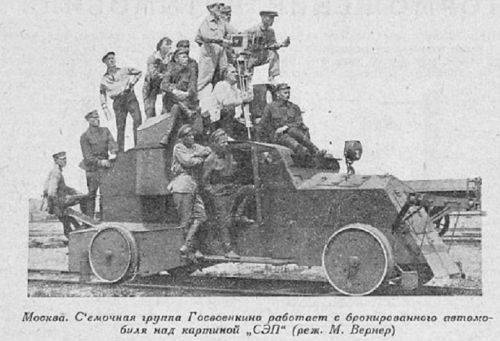
Information